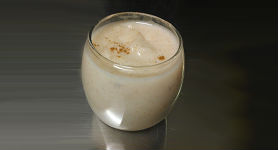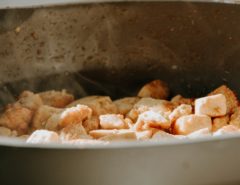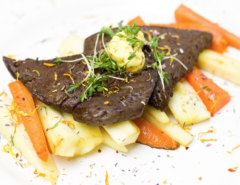By: Emily Del Bel
It never fails to amaze me to think of the types of foods that were invented without the detailed understanding of food chemistry that we have today, either by much trial and error, or accident. Hominy is the perfect example.
Hominy is a food that has been around for hundreds of years. Historically it was a staple of the Native American diet, and it still is a prominent figure in many Latin American cuisines. Hominy is field corn (not sweet corn) that has been treated with food grade calcium hydroxide in a process now known as nixtamalization. This process alters the chemistry of the tough, fairly inedible corn kernel, causing the endosperm to swell and soften. Ultimately it is transformed from a hard and tasteless mass into a soft and nutritious kernel.
Can you imagine how that was discovered? It probably happened when someone accidentally left lye or wood ash (historically used for cleaning) in the cooking pot. Of course I am totally guessing here, since an internet search yielded nothing. When ground, hominy forms masa harina, a flour used to make corn tortillas, tamales, and other yummy things. Hominy is also the basis for a delicious pudding common in Brazil known as canjica. I’ll share a recipe I developed below.
Hominy Coconut Pudding (Canjica)
- 2 c. canned white hominy, drained and rinsed
- 2 c. milk
- 1 c. shredded unsweetened coconut
- ½ – ¾ c. sugar, depending on your preference
- 1 c. water
- ½ teaspoon ground cinnamon
- 1/8 t. ground cloves
- ½ t. vanilla extract
- 2 T cornstarch
Place the milk, water, hominy coconut into a medium sized pot. On medium high heat, bring the mixture until warm, stirring frequently. At this point I grabbed my handy stick blender and pulsed it a few times to break up the kernels and larger coconut flakes. You could do this beforehand if you prefer. Actually, it would probably help prevent you from splashing it all over the stove like I did…
Have I mentioned that I am a messy cook?
Stir in the cinnamon, cloves, and vanilla, and slowly whisk the cornstarch in until thoroughly distributed. At this point you should be stirring constantly. Bring the mixture to a boil and hold there for 3-5 minutes, until thick. Remove from heat, and portion into individual cups. Let cool for a few minutes so you don’t burn your tongue, sprinkle with additional cinnamon and enjoy!
If you are interested in learning in more detail about the chemical changes that take place during nixtamalization, take a look at the paper “Changes in Corn and Sorghum during Nixtamalization and Tortilla Baking” by M.H. Gomez and others, published in the Journal of Food Science in 1989.
What kinds of foods fascinate you? Can you think of other foods that were discovered by accident? Share your thoughts in the comments below.






I love hominy. It’s a great addition to traditional soups or casseroles. The flavor is very unique.
Try yogurt.
I think about the origins of foods all the time! Take tea for example: who would have thought that taking a leaf, oxidizing it, and pouring hot water over it would produce a healthy drink?
Love this post! Cheese and beer always come to mind when you think of all the steps it takes to create them..you wonder how someone stumbled upon it. I think we’ve all heard the story of someone using a storage vessel made from an animal’s stomach to transport milk and the rennet caused curd and whey to separate creating cheese on accident. Who knows what happened but I’m glad it did! I’ve never had hominy but would sure like to try it. Love tortillas though, also made from corn masa!
I’m so glad to see that I’m not the only one who think about these things! We get to experience some really yummy things because of accidents!
Warning, shameless promotion for this food! My girlfriend is Brazilian and I was first introduced to canjica by her mum in our trip to Brazil this past winter break. Her mum informed me that when growing up, they would often make this as a dessert because it is so cheap and make a relatively nutritious dessert. I’m so glad you shared this recipe, Emily! Loved it